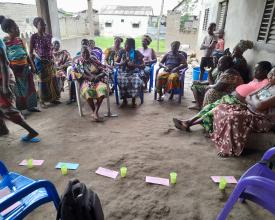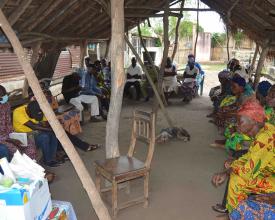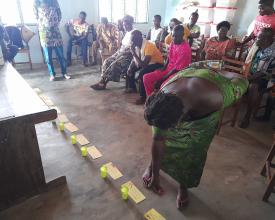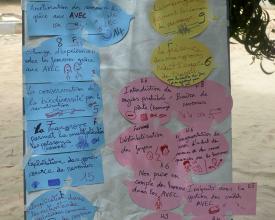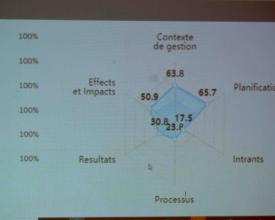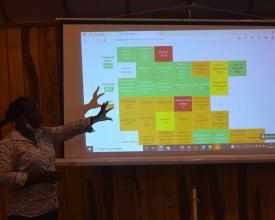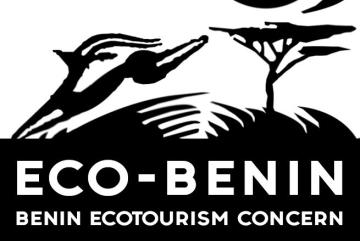
Utilización de las herramientas de evaluación IMET y SAPA para determinar las prioridades de actuación en la Reserva de Bouche du Roy.
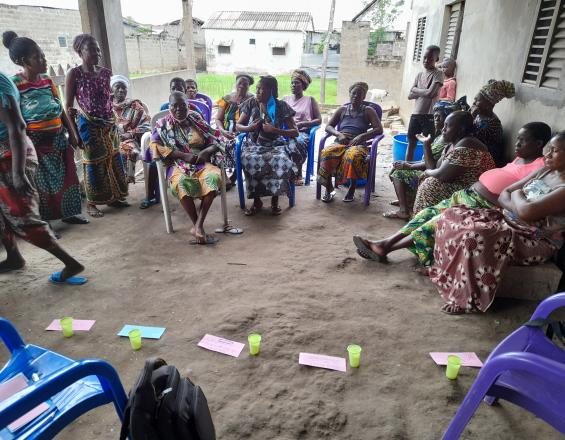
La Reserva de la Biosfera de Bouche du Roy se creó en 2017 para proteger los ecosistemas de manglares y costeros situados en el sitio RAMSAR 1017 de Benín, y comprende varios sitios, entre ellos Bouche du Roy. Alberga una población humana de más de 25.000 habitantes, la mayoría de los cuales dependen de la explotación de los recursos naturales para su supervivencia. El éxito de las acciones de conservación representa por tanto un verdadero reto. Por ello, hemos iniciado evaluaciones de la eficacia de la gestión y del impacto social con el fin de evaluar las principales repercusiones sobre la biodiversidad y el bienestar de las comunidades locales en el paraje de Bouche du Roy. Estas evaluaciones, realizadas con el apoyo del fondo de acción BIOPAMA, mostraron las carencias existentes en materia de seguimiento de la biodiversidad, personal técnico, recursos financieros y acciones de desarrollo local. A partir de estas carencias, se elaboró un plan de acción prioritario para reducir las lagunas detectadas y consolidar al mismo tiempo los logros alcanzados.
Contexto
Défis à relever
El sitio de Bouche du Roy de la Reserva de Biosfera del Delta del Mono, aunque dispone de un plan de gestión, se enfrenta cada vez más a problemas cuyas soluciones no estaban previstas en el plan de gestión cuando se elaboró. Además, el enfoque de la elaboración de los planes de gestión no siempre tiene suficientemente en cuenta los problemas sociales de las comunidades locales, que deberían estar en el centro de la conservación. Así pues, el primer reto consistió en elaborar un plan de acción basado en las investigaciones llevadas a cabo en las aldeas, con el fin de crear un repertorio de acciones que tuviera en cuenta las necesidades específicas de los distintos grupos de interesados. Además de elaborar este plan de acción, otro reto era difundirlo entre las partes implicadas en la gestión para que pudiera integrarse eficazmente en las intervenciones.
Ubicación
Procesar
Resumen del proceso
La creación del equipo local de facilitación para llevar a cabo la evaluación SAPA, seguida de su formación, fue el primer gran paso del proceso. Dado que la evaluación no podía llevarse a cabo sin la participación y consulta de las comunidades locales, su compromiso y movilización fueron esenciales para el buen desarrollo del proceso. Esta implicación, unida a la buena comprensión del método de evaluación por parte de los expertos locales, ha permitido obtener unos resultados de calidad, que coinciden en varios puntos con los de la evaluación IMET.
Bloques de construcción
Participación y movilización de las comunidades locales
Las evaluaciones IMET y SAPA son procesos comunitarios y participativos que requieren la implicación de las comunidades locales para garantizar la calidad de la evaluación. Para ello, antes del inicio de los talleres y reuniones de evaluación, se trabajó con los responsables de los lugares para identificar a todas las partes interesadas susceptibles de disponer de información esencial para la evaluación. Todas estas partes interesadas fueron informadas desde el principio de la acción prevista, de las distintas fases de la evaluación, de los objetivos perseguidos y de los resultados esperados y, por último, del uso futuro que se haría de los resultados obtenidos. Esta fase de información e implicación garantizó que las comunidades locales se implicaran plenamente y participaran de forma efectiva en todas las fases de la evaluación.
Factores facilitadores
Los talleres y las reuniones sobre el terreno se planificaron y organizaron en colaboración con las autoridades locales de los pueblos.
Todas las partes interesadas estuvieron representadas durante las actividades para recabar sus opiniones.
Los talleres comunitarios se realizaron con un enfoque lucrativo en el idioma local para garantizar la participación efectiva del mayor número posible de partes interesadas.
Las preguntas de evaluación se tradujeron a dibujos expresivos para mejorar la comprensión de la comunidad.
Lección aprendida
La inclusión de las comunidades locales como actores clave en la evaluación proporcionó una valoración real y precisa de la situación de la gestión del área protegida y del bienestar de las comunidades.
Los talleres comunitarios celebrados sobre el terreno en las lenguas locales atrajeron un alto nivel de participación. Esto permitió a todos los participantes expresar claramente sus sentimientos sobre el mecanismo de gestión implantado, las consecuencias para su bienestar y proponer enfoques para paliar sus dificultades.
Varias de las preguntas de evaluación se tradujeron a imágenes para que las comunidades locales participantes en los talleres comunitarios, en su mayoría analfabetas, pudieran entenderlas y responder adecuadamente.
Creación y formación del equipo de facilitación para llevar a cabo la evaluación SAPA
Evaluar el impacto social con la herramienta SAPA implica crear un equipo de facilitación multidisciplinar que reúna a diversos agentes y competencias para llevar el proceso a buen puerto. Este equipo debía estar coordinado por un experto especializado en el método SAPA. Dada la ausencia de un experto en el método SAPA a nivel local, recurrimos a un experto a nivel regional. Tras establecer contacto con el experto en SAPA, se constituyó el equipo local, formado por seis personas con competencias diversas pero complementarias en gestión de áreas protegidas. El equipo local de facilitación se benefició de varias sesiones de formación a distancia sobre la metodología SAPA para comprender mejor las especificidades de esta evaluación. El éxito de esta etapa de constitución del equipo de facilitación fue determinante para el proceso de evaluación y la calidad de los resultados.
Factores facilitadores
La existencia de un manual que describe la metodología SAPA fue de gran utilidad para el equipo de evaluación local que, además de las sesiones de formación impartidas por los expertos, pudo utilizar el manual para comprender en detalle las sutilezas de cada etapa de la evaluación.
La disponibilidad de competencias locales adaptadas a la evaluación SAPA y con un buen conocimiento del contexto de intervención facilitó la evaluación.
Lección aprendida
Este curso de formación para expertos locales nos ha demostrado que las competencias disponibles a nivel local son inestimables, y que es posible gestionarlas eficazmente para lograr los resultados deseados.
Pertinencia y concordancia de los resultados de las evaluaciones del impacto social (SAPA) y de la eficacia de la gestión (IMET)
La evaluación del impacto social se basó en un método participativo que consistió, en primer lugar, en consultar a las comunidades locales sobre su percepción de los impactos asociados a la existencia del área protegida y, a continuación, en realizar un análisis en profundidad de dichos impactos mediante una encuesta a una muestra de hogares y elaborar un plan de acción. En cada etapa de la consulta a las partes interesadas, se elabora un informe para las partes consultadas sobre los resultados obtenidos y los pasos siguientes. La evaluación IMET reunió a los mismos grupos de partes interesadas que la evaluación SAPA, pero en menor número y utilizando un método diferente basado en una serie de preguntas de evaluación. Al final del proceso, cada evaluación dio lugar a propuestas de actuación basadas en las lagunas detectadas. Aunque realizadas por equipos diferentes y utilizando métodos distintos, la mayoría de las acciones propuestas por los dos métodos de evaluación eran similares. Esto refleja la calidad de las investigaciones realizadas, una buena aplicación de la metodología y un buen análisis de los resultados. También podemos concluir que estos dos métodos, aunque se centren respectivamente en los impactos sociales y en la eficacia de la gestión, pueden ser complementarios en la evaluación de áreas protegidas.
Factores facilitadores
El rigor del método de evaluación fue decisivo para la obtención de los resultados. De hecho, aunque se trataba de métodos de evaluación diferentes, con sus respectivas etapas y metodología, se llegó a conclusiones similares en cuanto a las acciones que debían aplicarse como resultado de cada evaluación. También hay que decir que el buen conocimiento del lugar por parte de los expertos implicados en las evaluaciones les permitió realizar una evaluación precisa de la situación y proponer acciones ciertamente adecuadas.
Lección aprendida
En cuanto a las lecciones aprendidas, podemos decir que es importante, a la hora de realizar evaluaciones de áreas protegidas, recurrir a evaluadores especializados que, además de sus conocimientos metodológicos, tengan un cierto dominio del contexto de gestión del área protegida para realizar análisis más detallados y acordes con las realidades locales.
También creemos que en el contexto de las áreas protegidas comunitarias, la evaluación IMET por sí sola no es suficiente para identificar las prioridades de gestión. La fuerte presencia de comunidades en este tipo de áreas protegidas significa que el bienestar social de las comunidades locales debe tenerse en cuenta para que la gestión global del área protegida sea eficaz.
Impactos
Gracias a la elaboración de un plan de acción prioritario para el paraje de Bouche du Roy, los gestores han podido conocer mejor las acciones que han repercutido en las comunidades locales desde la creación del área protegida. Hasta la fecha, esto les ha proporcionado datos cuantitativos y cualitativos que justifican la necesidad de varias intervenciones, tanto en términos de refuerzo de las acciones de conservación de la biodiversidad como de herramienta de movilización de recursos para la conservación. Hasta la fecha, varias propuestas de proyectos de intervención para el sitio se han inspirado en las lagunas identificadas por las evaluaciones.
Beneficiarios
Comunidades locales del sitio de Bouche du Roy
Asociación para la Promoción y Conservación del Sitio de Bouche du Roy
Municipio de Grand-Popo
Municipio de Comè
Municipio de Kpomassè
Municipio de Ouidah
